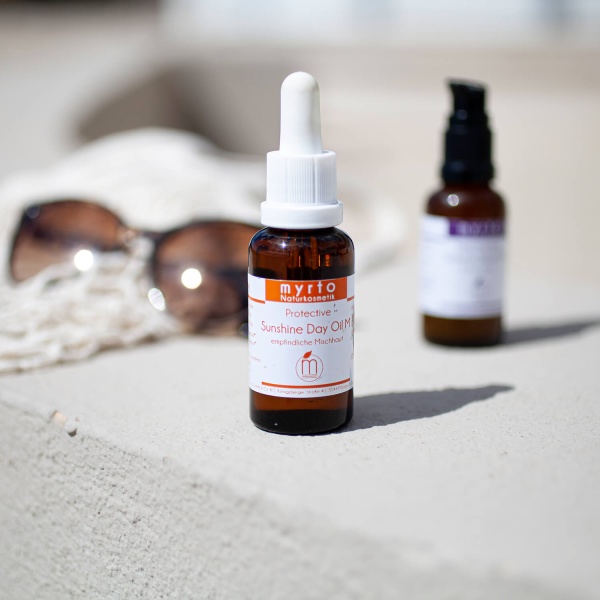As the seasons change, so do the needs of your skin. Therefore, a seasonally adapted facial and skin care is useful and necessary. In this blog post you will learn which particular stress factors affect your skin in summer and when it is hot and how you can best protect and care for your face.
How does your skin change in summer?
When the temperatures are high in summer, our blood vessels dilate (vasodilation) so that blood circulation increases. The sebaceous glands in the skin also produce more fat than at low temperatures. The likewise increased production of sweat when it is hot increases the moisture content on the skin. These weather-related changes lead to a generally improved complexion in summer: the complexion usually appears rosier, smoother and healthier, slightly tanned by the sun's rays.
The increased vitamin D content in the blood caused by sun exposure stimulates the body's own production of collagen fibres, which keep the connective tissue elastic and firm the skin contours.
Even if we find sweating in the heat annoying and uncomfortable, it not only acts as an ingenious natural air conditioning system for our body to lower the temperature. Sweating is also essential for detoxifying our skin from environmental pollutants and harmful microorganisms.
Harmful effects of the sun on the skin
Urban air pollution affects our skin in every season. In summer, most inner cities are also stuffy, muggy, and heated by concrete, asphalt, and glass surfaces that trap extra heat. The fine dust clogs the pores and promotes impurities such as pimples or blackheads.
The summer months with their long days invite us all the more to spend as much time as possible in nature, to fill up our vitamin D stores and to enjoy the sun - at the lake, on a hike, on the beach or by the sea.
However, one should not overdo it. Extensive sunbathing or sporting outdoor activities at midday with increased UV radiation, heat and high ozone levels are an enormous strain on the organism and harmful to our skin. Possible consequences can be:
- Sunburn
Sunburn with skin burns of the 1st to 2nd degree leads to redness, swelling and inflammation. Remember: Even the strongest sunscreen for the skin with SPF 50+ cannot block all damage from UV and IR radiation. - Oxidative stress
Too much sun, UV radiation or heat means oxidative stress for our cells. The balance between free radicals (prooxidants) and radical scavengers (antioxidants) gets out of balance. Oxidative stress damages cells, their structures and their function. - Premature skin aging
The sun strips your skin of moisture. Excessive UV radiation damages the collagen fibers of the connective tissue, so that the skin loses its elasticity, ages prematurely, becomes wrinkled and sagging. - Pigment spots
UV radiation stimulates the skin's melanocytes to produce more melanin. Melanin promotes the protective tanning of the skin, the so-called “photo callus”, but it also promotes the tendency to hyperpigmentation such as dark pigment spots. Like freckles, these round, elongated or oval skin changes are completely harmless. However, an unevenly colored, asymmetrical shape can indicate a harmful skin change. - Skin tumors
If you expose yourself to the sun without protection and risk sunburn, you increase your risk of skin cancer, especially if you have fair skin.
5 skin care tips for beautiful summer skin
- Tip 1: More moisture & Less fat-rich day creams
Rich moisturizing creams are used during the warm months at most overnight or for very dry skin. In summer, our skin tends to prefer facial serums with light textures that are quickly absorbed. At high temperatures, hydrating face serums with a fat content below 20% are also recommended instead of a day cream. Hyaluronic acid, aloe vera, ectoine and betaine are the most suitable, moisturizing active ingredients for your summer skin. Products with vitamin C, niacinamide, bakuchiol or magnolia bark have a lightening effect that evens out the complexion.
- Tip 2: Sensible sun protection
To protect yourself and your skin from the sun, you should avoid the blazing midday sun between 11 a.m. and 4 p.m. Also, protect yourself with a wide-brimmed hat, sunglasses, and covering clothing made from natural fibers. If you can't avoid the midday sun, remember to top up your sunscreen at least every 2 hours.
With the Sunshine Day Oil we recommend a purely plant-based sunscreen based on karanja oil and powerful antioxidants. It prevents premature skin aging and cell damage and strengthens the protective skin barrier. If necessary, apply a mineral sunscreen based on nanoparticle-free zinc oxide with SPF 30 to 50+.
-
Tip 3: Soothing face mask without emulsifiers
If your skin is dry, irritated or red after being in the sun, treat it to a soothing cream face mask . The emulsifier-free Regenerate Soothing Mask is ideal for this. It contains skin-tightening grape seed oil, beta-glucan to strengthen the skin barrier and powerful antioxidants from acai berry and sea buckthorn to stimulate cell renewal. -
Tip 4: Face toner for a refreshed summer complexion
The Bio Magnolia Toner Sensitive based on aloe vera gel provides immediate freshness, soothes sun-stressed skin and provides plenty of moisture. You can achieve an additional cooling effect if you keep the toner in the fridge during the hot summer months and apply it several times a day to refresh yourself. -
Tip 5: Regenerating facial oils
The high-quality myrto organic facial oils have an antioxidant, cell-renewing, smoothing effect and strengthen the skin's protective barrier – in summer ideally over your face serum instead of a day cream.












